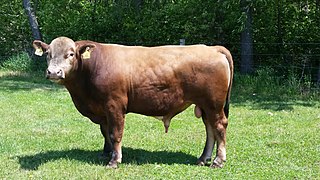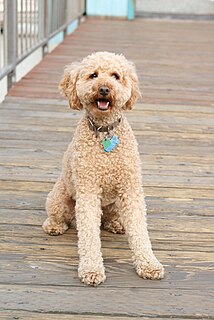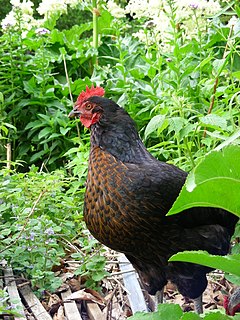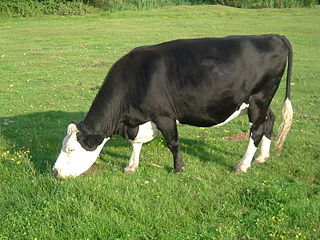
The Canchim breed is a breed of beef cattle developed in Central Brazil by crossing European Charolais cattle with Indubrazil cattle already kept in Brazil where Asian Zebu type cattle are best suited to the tropical conditions. When compared with Zebu bulls, Canchim bulls produce the same number of calves, but heavier and of superior quality. Compared to European breeds, the Canchim bull produces calves with the same weight but in larger numbers. The fast-growing progeny, from crossbred zebu cows with Canchim bulls, can be slaughtered at 18 months old from feedlots after weaning, up to 24 months old from feedlots after grazing and at 30 months from grazing on the range.

Beefalo, also referred to as cattalo or the Canadian hybrid, are a fertile hybrid offspring of domestic cattle, usually a male in managed breeding programs, and the American bison, usually a female in managed breeding programs. The breed was created to combine the characteristics of both animals for beef production.

Crossbreed dogs or designer dogs are dogs which have been intentionally bred from two or more recognized dog breeds and not from dogs with no purebred ancestors, but have not been artificially bred to each other enough to breed true and be recognized as a breed in their own right.

A crossbreed is an organism with purebred parents of two different breeds, varieties, or populations. Crossbreeding, sometimes called "designer crossbreeding", is the process of breeding such an organism, often with the intention to create offspring that share the traits of both parent lineages, or producing an organism with hybrid vigor. While crossbreeding is used to maintain health and viability of organisms, irresponsible crossbreeding can also produce organisms of inferior quality or dilute a purebred gene pool to the point of extinction of a given breed of organism.

Poodle crossbreeds or poodle hybrids are the offspring of purebred poodles that have been crossbred with another purebred dog breed. They may be described as a mixed breed dog, designer dog or, sometimes, as a hybrid dog.

A Eurohound is a type of dog bred for sled dog racing. The Eurohound is typically crossbred from the Alaskan husky group and any of a number of pointing breeds ("pointers").
In agriculture and in the hobby of animal fancy, a breeder is an individual animal used for selective breeding. Usually a breeder is a purebred animal bred with the intent of producing purebred or even show-quality animals. However, in some cases, a breeding animal is crossbred with another breed or a mixed breed with the intent of combining aspects of two or more different breeds.
Animal breeding is a branch of animal science that addresses the evaluation of the genetic value of livestock. Selecting for breeding animals with superior EBV in growth rate, egg, meat, milk, or wool production, or with other desirable traits has revolutionized livestock production throughout the world. The scientific theory of animal breeding incorporates population genetics, quantitative genetics, statistics, and recently molecular genomics and is based on the pioneering work of Sewall Wright, Jay Lush, and Charles Henderson.

The Spanish goat, also called the brush goat or scrub goat, came originally from Spain via Mexico to the USA. It is now a meat and brush-clearing type found widely in the United States. In the Southeast and elsewhere, they are often referred to as "wood" (Florida), "brush" or "briar", "hill" (Virginia), and "scrub" goats. Until recently, these goats were kept mainly for clearing brush and other undesirable plant species from pasture lands.The boer goats have overtaken Spanish goats for meat in the 1980s.

Sex-links are crossbred chickens whose color at hatching is differentiated by sex, thus making chick sexing an easier process. Sex-links come in several varieties. As hybrids of laying or dual-purpose breeds infused with extra vigor via heterosis, sex-links can be extremely good egg-layers which often produce 300 eggs a year or more depending on the quality of care and feed. The color of their eggs vary according to the mix of breeds, and blue-green eggs are possible.

A grade horse is a horse whose parentage is unknown, unidentifiable, or of significantly mixed breeding. This differs from purebred animals of known bloodlines and also differs from deliberately crossbred animals that are produced with an intent of either creating a new breed of horse or an animal with characteristics that deliberately combine the strengths of two different breeds. Many grade horses are the result of unintentional or accidental breedings, though in some cases, they are the result of a planned breeding of a stallion and a mare, but animals who themselves are of uncertain bloodlines.

The Black Hereford is a crossbreed of beef cattle produced in the British Isles with Hereford beef bulls with Holstein-Friesian dairy cows. Black Herefords are not usually maintained from generation to generation, but are constantly produced as a byproduct of dairy farming as a terminal cross. They are one of the most common types of beef cattle in the British Isles, outnumbering many pure beef breeds.

The Friesian Sporthorse is a Friesian crossbred of sport horse type. The ideal Friesian Sporthorse is specifically bred to excel in FEI-recognized sport horse disciplines. Thus, "sporthorse" refers to the phenotype, breeding, and intended use of these horses.

A purebred dog typically refers to a dog of a modern dog breed with a documented pedigree in a stud book and may be registered with a breed club that may also be part of a national kennel club.
The Comeback is a type of domestic sheep originating in Australia. This type of sheep results from crossbreds produced by British Longwool sheep and Merinos being mated back to Merinos. This cross is made to achieve a finer, better style of wool. Comeback style wool is also produced by Bond, Cormo and Polwarth sheep and they may prove easier to breed than Comebacks. The Comeback sheep are raised for meat and their fine wool.
The Black Hereford is a beef cattle breed, derived mainly from Hereford cattle, but with some mixture from black Angus cattle, resulting in black cattle with a white head and finching.
Purebred breeders are dog breeders that intentionally breed purebred dogs specifically to continue the lineage of certain breed characteristics in dogs by mating selected canines.

A designer crossbreed or designer breed is a crossbred animal that has purebred parents, usually registered with a breed registry, but from two different breeds. These animals are the result of a deliberate decision to create a specific crossbred animal. Less often, the animal may have more than two pure breeds in its ancestry, but unlike a mutt or a mongrel, its entire pedigree is known to descend from specific known animals. While the term is best-known when applied to certain dog crossbreeds, other animals such as cattle, horses, birds and cats may also be bred in this fashion. Some crossbred breeders start a freestanding breed registry to record designer crossbreds, other crossbreds may be included in an "appendix" to an existing purebred registry. either form of registration may be the first step in recording and tracking pedigrees in order to develop a new breed.














